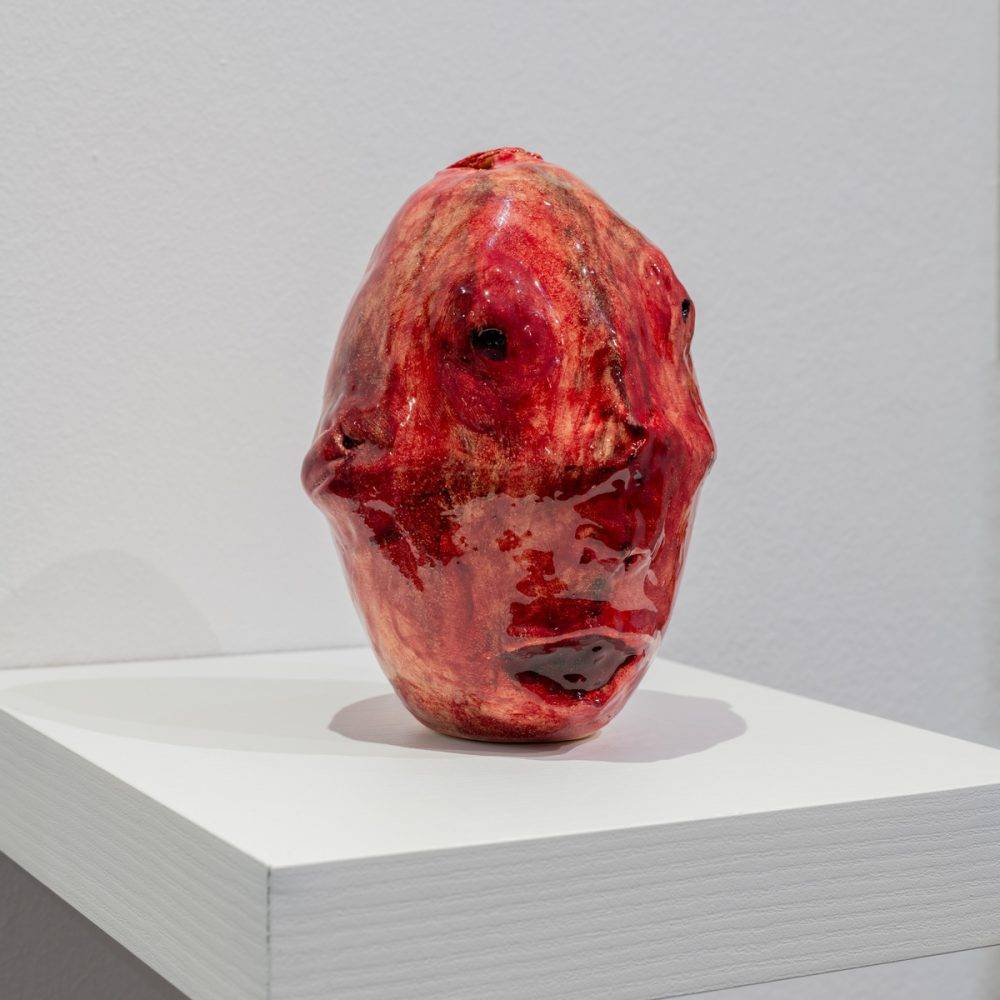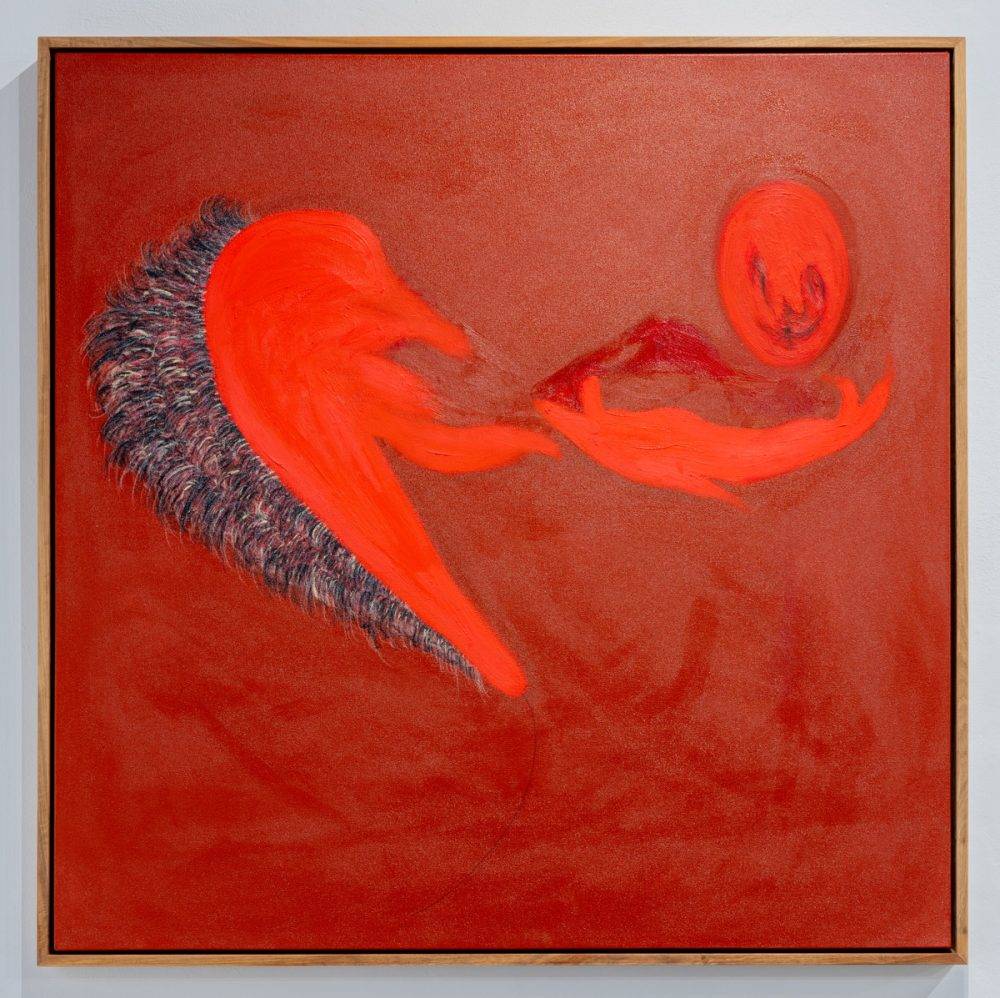Yolanda Mazwana’s exhibition at the Kalashnikovv Gallery in Cape Town. Photo: Johann Lourens Photography
In an intimate and playful offering What Her Body Does brings together paintings and ceramic sculptures, subtly teasing at the thread of desire, the feminine and explorations of self. The first major solo exhibition by Yolanda Mazwana at Kalashnikovv Gallery in Cape Town, What Her Body Does is a significant milestone for the artist who assembles a chamber of drama and humour through sensual bodies floating in space.
The palette is deliberately restrained, largely red. This restraint is not merely an aesthetic choice but rather, it is integral to the conceptual framework Mazwana seeks to build upon. Various articulations of red, accompanied by small planes of black and even smaller patches of white, amplify and accentuate the emotional impact within the work.
Of this colour, art critic and novelist John Berger writes: “Red is not usually innocent.” He speaks of a red of eyelids shut tight, the heaviest red in the world. A red by which you swear to love forever. A red whose father is the knife. A red that is continuously asking for a body.
Mazwana offers that body which red seeks. She reimagines the female form through a free-flowing technique conflating the real and the imagined. The body as desired, as judged, as gazed upon and often fantasised. The body as an enigma and spectacle. The body is depicted with nuance, excavating an archive of feelings of sensory embodiment. The work delves into the physicality of the human form, particularly the woman’s body, while also reclaiming the body as a site of selfhood.
Mazwana is attentive to how the body functions, how muscles contract and relax, and how the limbs fold and release. The figures are not merely representations of identity or desire but are studies in the physicality of the body. The arching of a back, the bending of a limb — these are not just visual artistic choices but explorations of how the body functions.
She notes: “The exhibition is a study in the body’s capabilities — the big emotions it holds, the subtle sensations it registers, the uncomfortable sensitivity, and the beautiful sensuality it embodies.
“The figures are unmistakably human, yet the emphasis is not on who they are but on what their bodies are doing — how they interact with the world around them and with their own internal experiences.”
In The Weight of Weariness, a mixed media work rendered on Fabriano paper, tiny humans (or perhaps splotches of blood) float inside a bubble. The interaction between the deep red of the background and the slightly paler version produces a discomforting sensation, at once repulsive and sensual.

 Red in ladies: Yolanda Mazwana’s exhibition at the Kalashnikovv Gallery in Cape Town includes her debut foray into sculpture, and paintings of floating shapes, mainly in shades of red, that represent the sensuality of the female form.
Red in ladies: Yolanda Mazwana’s exhibition at the Kalashnikovv Gallery in Cape Town includes her debut foray into sculpture, and paintings of floating shapes, mainly in shades of red, that represent the sensuality of the female form.
The sense of the sensual courses through the entire portfolio. The sensual as erotic, the sensual as pleasure, “what could possibly be gobbled up” and devoured, perhaps after author Katherine Young, who writes beautifully about the sensual as a “phenomenology of pleasure”.
In her seminal text, The Uses of the Erotic: The Erotic as Power, Audre Lorde disentangles women’s eroticism from its cultural misuse and calls for a realisation of the erotic as a source of power.
For Lorde, the erotic is located in desire, in creative force and the sensually beautiful. She notes: “There are many kinds of power, used and unused, acknowledged or otherwise. The erotic is a resource within each of us that lies in a deeply female and spiritual plane, firmly rooted in the power of our unexpressed or unrecognised feeling.”
This power is evident Buoyant Reverie, an acrylic and oil painting in red and black in which a figure is depicted in an arched posture. The teardrop-like face turns towards the back of the bent body — the bent back is curved and relaxed. The hips and bum are gently turned outward and upward in a composed stance.
Here the viewer’s eye rests toward the small patch of textured mark-making distinct from the rest of the smoothness of the surface elsewhere. This is what the artist refers to as her “flaky blob” technique, a method in which she executes marks of a jittery, textural nature, evoking a visceral and layered quality.
She explains: “The ‘flaky blob’ technique emerged while I was in residency at Nirox Sculpture Park, where I was inspired by spider webs and other textures in the environment. I would see spiders crawling and this created an irrational fear.”
In response to this, Mazwana developed this mark-making method as a way to speak of the weird sensations she felt on her body.
She elaborates: “This technique is a deliberate exploration of the jittery feelings that crawl across the skin — the shivers, the tingles, the goosebumps that are as much a part of our bodily experience as breathing or moving.”
This method is depicted more obviously in the work Contemplations of the Flaky Leg, a fragmented and abstracted work with shadowy and spectral patches of paint hovering behind the foregrounded form.
The titles of the works too, function as a guidepost, revealing the artist’s internal inquiries and preoccupations. For instance, Folding Inwards evokes a desire for comfort and safety, states which can be read through the combination of rounded, curved forms alongside a stretch of flaky blob generously depicted on the left of the canvas.
Often Mazwana begins with preparatory drawings to make her paintings. Here too, red features in thin and unobstructed lines. From afar, it seems as if these scribbles are mere shapes and forms but considered closely, they become people.
In these studies, one finds a looseness of gesture, a kind of stream-of-consciousness free motion where human and non-human shapes contort and merge. This openness to play lends itself to experimentation, not only in technique but in the types of mediums that can be explored.
In What Her Body Does Mazwana debuts a selection of ceramic works, bridging the immediacy of drawing and painting against the slowness of hand-building with clay. She begins with raw clay, layering coils to build her forms that are weird, grotesque and strangely alluring.
These otherworldly figures possess a delicate grace. They are unsettling and mesmerising, filled with mystery and charm. Her experimentation with sculpture allows engagement with different materials but also permits a nuanced exploration of texture, structure and dimensionality.
Mazwana prioritises a visual language that makes it possible to see oneself through the other — and to see the other through oneself. The figures she renders begin with the artist thinking about her own body.
The genesis of I slowly shifts to become multiple Is. The figures are me and you. This is critical as it makes the work communal. This sense of co-mutuality reminds me yet again of Lorde for whom the erotic is deeply embedded with shared pursuits.
She notes: “The erotic functions for me in several ways, and the first is in providing the power which comes from sharing deeply any pursuit with another person. The sharing of joy, whether physical, emotional, psychic, or intellectual, forms a bridge between the sharers which can be the basis for understanding much of what is not shared between them, and lessens the threat of their difference.”
The kind of universality embodied in the figures emanates from her vision to make works that are deeply resonant. Malleable Sentiments: The Blobs Expressions, for instance, reflects on what Mazwana calls “the transformation of the amorphous shape of a vessel of emotion”.
To be amorphous is to lack a defined shape, formless, porous, fluid. This fluidity is communicated through a sense of rhythm and vitality, suggesting a state of liveliness and pliability. Perhaps this registers Mazwana’s own quest for pliability and seeing, seeking and defining herself as an artist and woman.
The identity of a woman is not one she shies away from. She locates her work through tradition of women and non-binary artists who approach painting conceptually, stating: “Painting has been a central part of my identity since my early twenties.”
This medium that has been part of her process for so long allows her to think through how she navigates life. And now, it is accompanied by a new thread through sculpture making.
What Her Body Does marks a significant moment in Mazwana’s journey, offering a portrayal of the body as a site of eroticism, desire and self-discovery. She reimagines the female form inviting viewers to reflect on their own emotional and phenomenological experiences.
What Her Body Does is at the Kalashnikovv Gallery in Cape Town until 28 September.